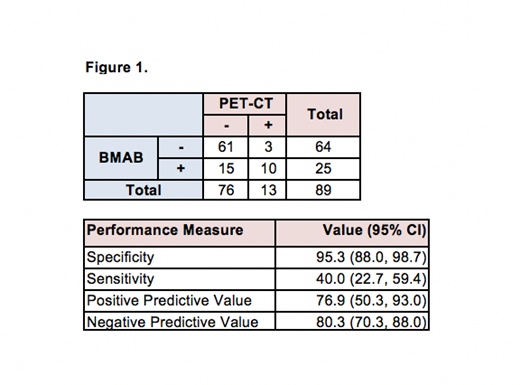Introduction:
T-cell lymphomas (TCL) are a heterogenous group of lymphoid malignancies that account for 10-15% of all lymphoproliferative disorders. Histological bone marrow involvement (BMI) ranges between 20-40% of all TCLs at time of diagnosis with bone marrow aspirate and biopsy (BMAB) considered the gold standard test to detect BMI. 18-Fluoro-deoxyglucose positron emission tomography combined with computed tomography (PET-CT) is a standard pretreatment imaging in the staging of TCL. In other lymphomas like DLBCL, PET-CT may obviate the need for BMAB as a component for staging, but this has not been studied in TCL. The aim of this retrospective study is to determine the accuracy of PET-CT in detecting BMI in newly diagnosed TCL.
Methods:
This is a single institution retrospective medical chart review study. All TCL patients(pts) diagnosed at Roswell Park Cancer Institute between January 2003 to December 2017 and underwent pre-treatment PET-CT and BMAB were included. PET-CT images were visually assessed for BMI. We excluded cases in which BMAB specimens were qualitatively and/or quantitatively insufficient to determine the presence or absence of BMI. Ann Arbor staging was determined using PET-CT and BMAB and the proportion of patients upstaged to Stage IV due to BMI detected by either modality was calculated. The BMAB and PET-CT results were summarized using a 2x2 contingency table. The performance of the PET-CT was evaluated using the sensitivity, specificity, positive predictive value, and negative predictive value. Confidence intervals for these measures were obtained using Jeffrey's prior method.
Results:
In total 89 pts were included in the analysis. Median age at time of diagnosis was 60 (range 20-92), 52 were male (58%), 20 had elevated LDH (22%), 7 had ECOG greater or equal to 2 (8%), 66 had an IPI score 0-2 (74%) and 23 had an IPI score 3-4 (26%), 7 had >2 extra-nodal sites of involvement (8%). In total, 38 pts (42.6%) had BMI at time of diagnosis, established by either BMAB (n= 25; 28%), PET-CT (n=13; 15%) or by both modalities (n=10 pts; 11%). There were 15 pts (17%) that were negative for BMI on PET-CT but had positive involvement of TCL on BMAB. The sensitivity and specificity of PET-CT to detect BMI by TCL was 40% (95% CI 22.7, 59.4) and 95.3% (95% CI 88.0, 98.7), respectively. Seventy-one pts (79.7%) had concordant results between lymphomatous BMAB and PET-CT (10 pts were positive for both, 61 pts were negative for both) and 18 pts (20.2%) had discordant interpretation (15 pts were negative by PET-CT and positive by BMAB and 3 pts were negative by BMAB and positive on PET-CT). BMAB upstaged 4 out of the 32 (12.5%) stage I-II pts to stage IV; out of these only 1 patient had positive BMI detected by PET-CT. The positive predictive value of PET-CT for detecting BMI was found to be 76.9 % (50.3, 93.0) with a negative predictive value of 80.3 % (70.3, 88.0) (Figure 1).
Conclusion:In our cohort of TCL pts, staging PET-CT does not identify all cases with BMI. BMAB upstaged more pts with Stage I/II to Stage IV than PET-CT. Although PET-CT has high negative predictive value for ruling out marrow involvement by TCL, BMAB remains a necessary component in the evaluation of pts with newly diagnosed TCL because of its ability to detect lymphomatous involvement of bone marrow missed by PET-CT which has implications in staging and treatment of TCL.
No relevant conflicts of interest to declare.
Author notes
Asterisk with author names denotes non-ASH members.


This feature is available to Subscribers Only
Sign In or Create an Account Close Modal